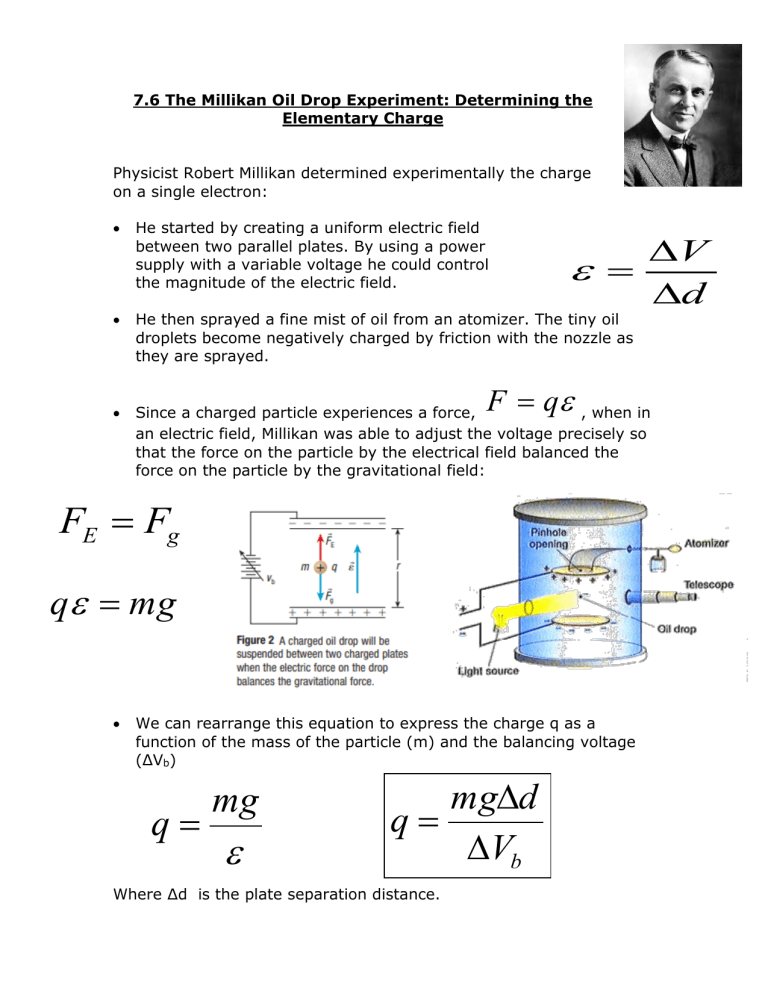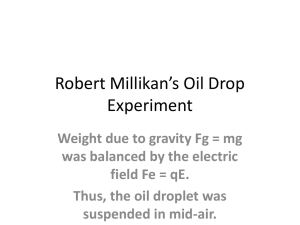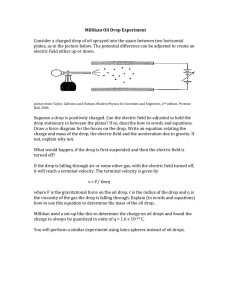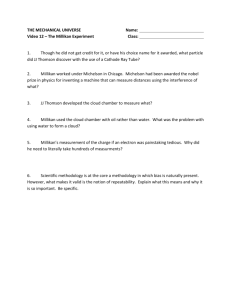
7.6 The Millikan Oil Drop Experiment: Determining the Elementary Charge Physicist Robert Millikan determined experimentally the charge on a single electron: He started by creating a uniform electric field between two parallel plates. By using a power supply with a variable voltage he could control the magnitude of the electric field. V d He then sprayed a fine mist of oil from an atomizer. The tiny oil droplets become negatively charged by friction with the nozzle as they are sprayed. Since a charged particle experiences a force, , when in an electric field, Millikan was able to adjust the voltage precisely so that the force on the particle by the electrical field balanced the force on the particle by the gravitational field: F q FE Fg q mg We can rearrange this equation to express the charge q as a function of the mass of the particle (m) and the balancing voltage (ΔVb) q mg mgd q Vb Where ∆d is the plate separation distance. Millikan determined the mass by turning off the electrical field and measuring the final speed of the droplets as they fell under gravity onto the bottom plate. Since it was impossible for Millikan to determine the number of extra electrons in any particular droplet, he repeated the experiment many times and looked for a pattern. The charge on any droplet turned out to be a multiple of some small value. There were no trials that had results smaller than this elementary charge. The elementary charge on one single electron was determined to be e= -1.602 x 10-19C To determine the total charge q on an object with an excess or deficit of N number of electrons use the equation. q=Ne EXAMPLES Example 1: Find the number of electrons needed to give an oil drop a charge of 4*10-8 C. Example 2: A 5*10-15 kg oil drop is balanced between two plates, separated by 2 cm, with a voltage of 600 Volts. Find the charge on the drop. SOLUTION Example 1: Find the number of electrons needed to give an oil drop a charge of 4*10-8 C. q=Ne N = q/e Solution 1: N = 4*10-8/1.6*10-19 = 2.5*1011 electrons. Example 2: A 5*10-15 kg oil drop is balanced between two plates, separated by 2 cm, with a voltage of 600 Volts. Find the charge on the drop. Solution 2: V = Ɛ * r 600 = Ɛ (0.02) Ɛ = 30,000 N/C mg = qƐ (5*10 )(9.8) = q (30,000) -15 Therefore q=1.6*10-18 Coulombs, or 10 electrons. Textbook Work Section 7.6: The Millikan Oil Drop Experiment Chapter 7 Review Self-Quiz - Page 369 # 18 Review - Pages 370- 375 # 117, 5565, 6790 - Practice p. 364# 13 - Page 365 # 16







